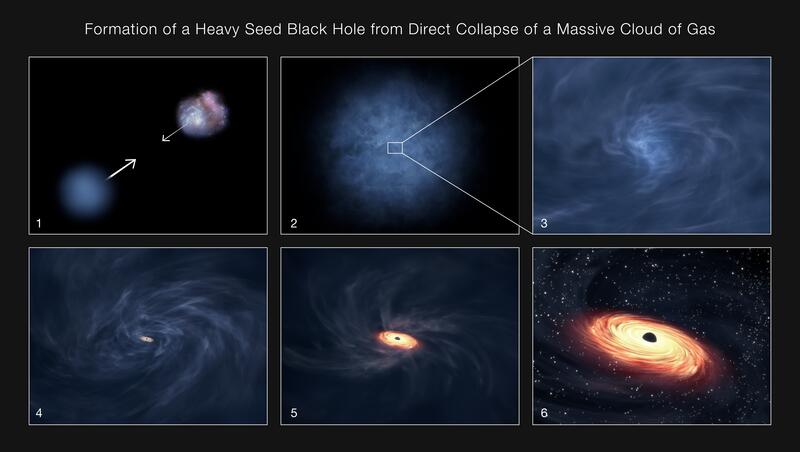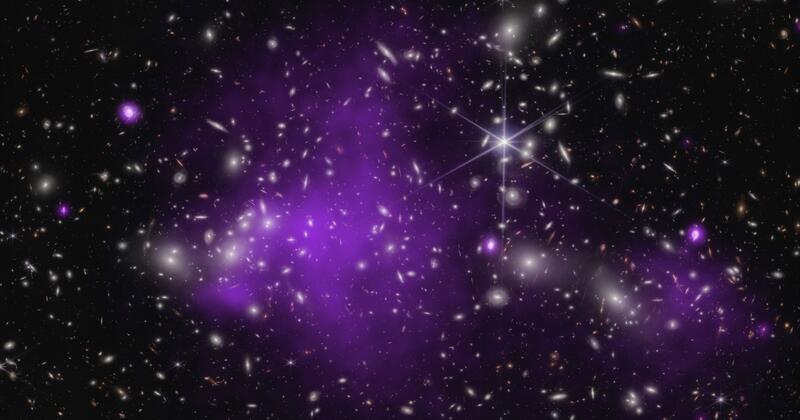space
Updated November 9, 2023 at 4:38 p.m
A look back more than 13 billion years shows that a powerful black hole would have formed very quickly at that time. Only one of two possible theories for its origin can be considered.
A few hundred million years after the Big Bang, black holes with a million times the mass of our Sun existed in the early universe. How could these gravity monsters arise so quickly? An international research team is now much closer to answering this question.
“The origin of black holes remains a mystery.”
Using several telescopes, astrophysicists have identified a black hole that actually reached between ten and one hundred million solar masses 500 million years after the Big Bang. Scientists write that this black hole could have formed so quickly only through the direct collapse of a large gas cloud In the journal “Natural Astronomy”.
Almost all galaxies have supermassive black holes at their centers. If gas flows into black holes from the outside, it heats up and glows brightly. Astronomers call these bright galactic centers, which shine brighter than the entire surrounding star system, quasars. “Previous observations have already shown that quasars existed 700 million years after the Big Bang,” explain Akos Bogdan from the Harvard-Smithsonian Center for Astrophysics in Cambridge, USA, and his colleagues. “But the origin of these black holes remains a mystery.”
Two scenarios are possible
There are two main scenarios under discussion. The first scenario attributes supermassive black holes to the first generation of stars in the universe. These first stars were large and short-lived, and may have produced black holes of tens to hundreds of solar masses. The second scenario assumes the direct collapse of large gas clouds, which could lead to the emergence of black holes with a mass of up to one hundred thousand solar masses. In both scenarios, these first black holes grow to their subsequent size due to the flow of gas.
Bogdan and his colleagues used the James Webb Space Telescope and the Chandra X-ray Observatory to search for massive black holes even in the early universe. They took advantage of a strange feature of nature: the galaxy cluster Abell 2744, 3.6 billion light-years away, uses its gravity to deflect the light of distant celestial objects behind it in such a way that it acts like a massive lens. This allowed astronomers to find very distant galaxies that would have remained invisible if not for the magnification effect.
The team was successful: in the galaxy UHZ1, researchers found a quasar that revealed itself through intense X-rays. This radiation took 13.3 billion years to reach Earth. So Bogdan and his colleagues look into the cosmic past and see the galaxy and the black hole as they appeared 13.3 billion years ago, just 500 million years after the Big Bang. From the radiation intensity measured by the Chandra X-ray satellite, astronomers determined a mass of between ten and one hundred million solar masses for the central black hole UHZ1.

© NASA/STScI/Leah Hostak via dpa
Conclusion: Black holes are not formed from stars
Regardless of the scenario, the first black holes may have formed no later than 200 million years after the Big Bang. “This means that the black hole we discovered in UHZ1 had only 200 million years to grow to its current size,” Bogdan and his colleagues note. Based on theoretical models, the researchers concluded that formation from a star is not a likely explanation: a black hole with a maximum initial mass of one hundred solar masses cannot absorb enough matter during this time.
This leaves it as the result of the collapse of a large gas cloud. The researchers’ calculations show that an initial mass ranging from ten to one hundred thousand solar masses would be sufficient for the black hole to grow to the observed size. At least it is possible that the black hole in UHZ1 formed in this way. The search for quasars in the young universe continues now, to verify whether this quasar is the rule or perhaps just an exception. (Rainer Kaiser, dpa/mac)

Researchers at the International School for Advanced Studies (SISSA) in Italy have counted the existing stellar black holes.

“This is how the editorial team works“It teaches you when and what we report bugs, how we handle bugs and where our content comes from. When reporting, we adhere to guidelines Journalism Trust Initiative.

“Prone to fits of apathy. Zombie ninja. Entrepreneur. Organizer. Evil travel aficionado. Coffee practitioner. Beer lover.”






More Stories
New WhatsApp functionality – Green Heart brings changes to the messaging service
Grand Theft Auto VI: Are these the cast of the two heroes?
Zombies from the Samsung Galaxy S24 Ultra camera: This is how bad a quickly aging close-up photo currently looks online